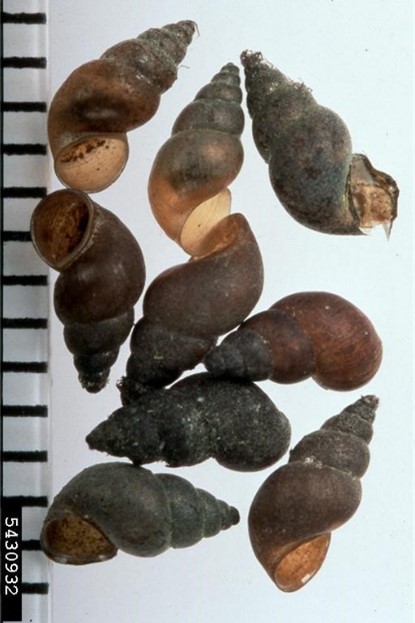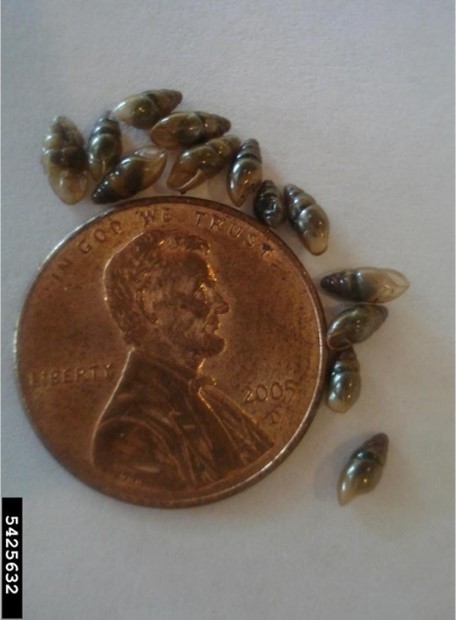New Zealand mud snail
Learn more about New Zealand mud snail and how you can help prevent the introduction and spread of this invasive species.
What Ontario is doing
To prevent the further spread of this species in the province, Ontario has regulated New Zealand mud snail (Potamopyrgus antipodarum) as a prohibited invasive species under the Invasive Species Act, 2015.
Learn about the Invasive Species Act and regulations.
Background
New Zealand mud snail is an invasive aquatic snail that inhabits freshwater habitats, including:
- rivers
- creeks
- streams
- ponds
- lakes
- constructed waters like canals and ditches
Reported to be found at depths of 4 to 25 m in Lake Ontario, these snails reside along the shorelines and are capable of surviving year-round in Ontario’s Great Lakes over a range of temperatures and salinities.
New Zealand mud snail can spread naturally on wildlife such as birds. It can also be carried in ship ballast water or by hitchhiking on recreational watercraft and other contaminated equipment.
Females become sexually mature within three to six months. They can reproduce asexually, resulting in offspring genetically identical to the mother. This means only one female is needed to establish a population.
Range
New Zealand mud snail is native to New Zealand and its adjacent islands. However, it is widely established across Europe, Australia, Asia and North America.
Arriving in Lake Ontario in 1991, it has since spread to other areas including Lake Erie, Lake Superior, Lake Michigan and the St. Lawrence River.
View an up-to-date distribution map of New Zealand mud snail in North America.
Impacts of New Zealand mud snail
New Zealand mud snails form very dense colonies, with up to 300,000 per square meter reported. New Zealand mud snail can outcompete native snails and other aquatic invertebrates for food and habitat.
Large populations can lead to the overconsumption of plants and detritus, altering the available nutrients for aquatic food webs. Damage to the aquatic ecosystem and food chain can decrease commercial fish populations, impacting the fishing industry.
How to identify New Zealand mud snail
The New Zealand mud snail is very small, 8 mm or less. It has an elongated shell which is slender and pointed with five to seven whorls (spirals). They are grey to dark brown in colour.
What you need to know
- Learn how to identify New Zealand mud snail and how to prevent the introduction or spread of this animal into new waterbodies.
- It is illegal to deposit, release, possess, transport, propagate, buy, sell or trade this species in Ontario.
- Always clean, drain, and dry your watercraft (such as a boat or canoe) before transporting it to another waterbody.
- As of January 1, 2022, boaters in Ontario must take reasonable precautions to remove all plants, animals and algae as well as remove drain plugs to allow water to drain from their vessel before transporting it overland. Boaters must also ensure their boat is free of all plants, animals and algae before arriving at a boat launch or launching their boat into any waterbody.
- Never buy, sell, lease or trade New Zealand mud snail or keep in aquariums or outdoor gardens.
Reporting illegal activity
If you have any information about the illegal importation, distribution, or sale of New Zealand mud snail, report it immediately to either:
- the ministry at
1-877-847-7667 , toll-free anytime - Crime Stoppers anonymously at
1-800-222-TIPS (8477)
If you’ve seen New Zealand mud snail or another invasive species in the wild, please:
- contact the toll free Invading Species Hotline at
1-800-563-7711 - visit EDDMapS Ontario
- search for the ‘Invasive Species in Ontario’ project on iNaturalist.org to report a sighting
Gallery
Photo: Mohammed El Damir, Bugwood.org
Photo: Mike Gangloff, Bugwood.org

